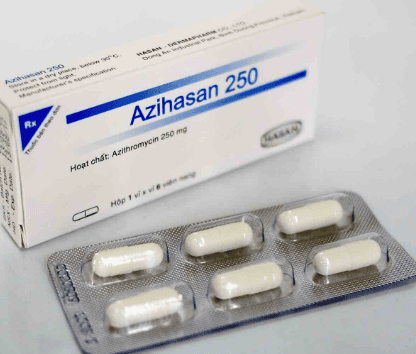This is an automatically translated article.
Erybact is an antibiotic belonging to the Macrolide group that is widely used thanks to its broad spectrum of action against bacteria. However, consuming forms of Erybact still have certain side effects, so users need to be careful when taking this antibiotic.1. What is Erybact?
Erybact drug is the main ingredient is Erythromycin - Macrolide antibiotic has mainly bacteriostatic effect against Gram-positive, Gram-negative bacteria and other bacteria such as Mycoplasma, Spirochetes, Chlamydia and Rickettsia. In addition, strains of bacteria that are sensitive to Erybact include:Gram (+): Bacillus anthracis, Corynebacterium diphitea, Erysipelothrix rhusiopathiae, Listeria monocyogenes,... Gram (-): Neisseria meningitidis, N. gonorrhoeae , Moraxella catarrhalis, Bordetella spp, Pasteurella, Haemophilus ducreyi, Helicobacter pyloridis, Campylobacter jejuni,... Other bacteria: Actinomyces, Chlamydia, Rickettsia spp, Spirochete Treponema pallidum and Borelia burgdorferi, Mycoplasma scròukaneryas, Mycoplasma scròulaceum and Mycoplasma Ingredients such as:
Sulfamethoxazole is a sulfonamide that competitively inhibits folic acid synthesis in bacteria Trimethoprim is a pyrimidine derivative that specifically inhibits the bacterial enzyme dihydrofolate reductase The combination of three antibiotics is both bacteriostatic both bactericidal will increase the effectiveness as well as the antibacterial spectrum of Erybact.
2. Indications and contraindications of Erybact:
Erybact is indicated in the treatment of gram-negative and gram-positive bacterial infections, especially gonococcal infections, uncomplicated acute urinary tract infections and patients with Pneumocystis carinii pneumonia. Specific indications of Erybact are as follows:
Bacterial infections sensitive to sulfamethoxazole and trimethoprim Urinary tract infections Bacterial prostatitis Respiratory infections Acute exacerbation of chronic bronchitis Acute sinusitis in adults Bacterial infections Digestive (bacillus dysentery) In addition, contraindications to Erybact include:
Patients with hypersensitivity to any component of the drug Patients with liver disorders or a history of hearing impairment after use Use of Erythromycin Patients with acute porphyria, Severe renal failure, unmonitored plasma concentrations Patients with megaloblastic anemia due to folic acid deficiency Children under 2 months of age Contraindicated in combination with Terfenadine specifically especially in cases of patients with heart disease, arrhythmias, bradycardia, prolonged Q-T interval or ischemic heart or electrolyte disturbances.
3. Dosage of Erybact:
Erybact is marketed in two main forms, powder or tablet. Depending on the form of existence, the use of Erybact is also different. In the case of Erybact 365 oral powder, the usage is as follows:
How to use: Mix the medicine with a little water just enough about 10-15 ml. Reference dosage depends on age: children from 2 months to 5 years old use. dose 1/3-1/2 sachets/time, from 5-12 years old use 1 pack/time and over 12 years old use 1-2 packs/time. Adult with reference dose is 1 tablet x 3 times/day
4. Possible side effects of Erybact:
Common side effects of Erybact include: fever, nausea, vomiting, abdominal pain, diarrhea, glossitis, itching or rash. Less common may be eosinophilia, leukopenia, neutropenia, purpura or urticaria. Rare but severe cases of adverse reactions include:
Anaphylaxis, serum sickness, megaloblastic anemia, hemolytic anemia Aseptic meningitis Toxic epidermal necrolysis , Stevens-Johnson syndrome, erythema multiforme, angioedema, photosensitivity Jaundice, hepatic cholestasis, hepatic necrosis Hyperkalemia, hypoglycemia Hallucinations Renal failure, interstitial nephritis, kidney stones Ù , deafness (reversible) Arrhythmia
Please dial HOTLINE for more information or register for an appointment HERE. Download MyVinmec app to make appointments faster and to manage your bookings easily.













